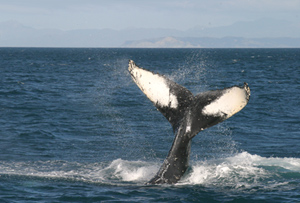 |
 |
 |
 |
 |
 |
 |
 |
 |
 |
  |

|
|
Home > Environmental Issues > Article > |
|

Underwater noise:
|
|
Noise from just a single seismic survey can flood through a region of almost 300,000 sq.km, raising noise levels 100 times higher, continuously for days at a time (IWC 2004). |
|
Loud air guns with a sound level of 200 to 250 decibels are used for seismic surveys by the oil and gas industry to find oil up to 10km underneath the ocean floor. Seismic noise from eastern Canada measured 3,000 km away in the middle of the Atlantic was the loudest part of the background noise heard underwater (Nieukirk et al. 2004). Ocean background noise levels have doubled every decade for the last six decades in some areas, mainly due to shipping (IWC 2004). Such noise can prevent fish, whales, and dolphins from hearing their prey or predators, from avoiding dangers, from navigating or orienting to important habitat, from finding mates that are often widely spread out, or from staying in acoustic contact with their young or their group members. |
|
Whale calls seem to be becoming increasingly drowned out by our noise (Nieukirk et al. 2004). |
|
What kinds of impacts from noise on marine life have been found?Recently, noise has been shown to be deadly for at least some species of whales. The evidence linking intense military sonars with fatal whale strandings is undeniable (e.g. Frantzis 1998; Jepson et al. 2003). The International Whaling Commission's Scientific Committee noted "there is now compelling evidence implicating military sonar as a direct impact on beaked whales in particular" (IWC 2004). Even a U.S. Navy-commissioned report stated that "the evidence of sonar causation [of whale beachings] is, in our opinion, completely convincing." (Levine et al. 2004) Often whales show bleeding around their brain, in their ears, in other structures to do with hearing, and in other organs of their body (e.g. NOAA and U.S. Navy 2001; Fernandez et al. 2005). Mass strandings of certain types of whale increased dramatically after 1961 when more powerful naval sonars began to be used (Friedman 1989). Seismic air guns have been thought to cause whale strandings as well (Taylor et al. 2004; Engel et al. 2004). Even giant squid have apparently mass stranded because of air guns, suffering massive internal injuries and badly damaged ears (MacKenzie 2004). Many sub-lethal effects have also been documented. These may be as serious as lethal effects, because they may affect more animals yet be harder to detect. Seismic air guns have been shown to severely damage fish ears, most likely permanently, at distances of from 500m to several kilometers from seismic surveys (McCauley et al. 2003). Reduced catch rates of 50-80% and fewer fish near seismic surveys have been reported in species such as cod, haddock, rockfish, herring, and blue whiting (Engas et al. 1996; Dalen and Knutsen 1987; Lokkeborg 1991; Slotte et al. 2004; Skalski et al. 1992). These effects can last up to five days after exposure and at distances of more than 30 km from a seismic survey. Increases in stress hormones (Santulli et al. 1999) and strong behavioral reactions have been observed in fish due to noise. Day-to-night movements of fish were changed near air guns (Wardle et al. 2001). Fish also showed reactions like dropping to deeper depths, becoming motionless, becoming more active, or forming a compact school (Dalen and Knutsen 1987; McCauley et al. 2000; Pearson et al. 1992; Santulli et al. 1999; Skalski et al. 1992; Slotte et al. 2004). Snow crabs under seismic noise conditions showed bruised organs, abnormal ovaries along with bleeding, stress, delayed embryo development, and smaller larvae (DFO 2004). |
|
ReferencesAndre, M, Kamminga, C., and Ketten, D. 1997. Are low-frequency sounds a marine hazard: a case study in the Canary Islands. Underwater Bio-sonar and Bioacoustics Symposium, Loughborough University. Balcomb, K.C. and Claridge. D.E. 2001. A mass stranding of cetaceans caused by naval sonar in the Bahamas. Bahamas J. of Science 8(2): 1-12. Bryant, P.J., C.M. Lafferty, and S.K. Lafferty. 1984. Reoccupation of Laguna Guerrero Negro Baja California, Mexico, by gray whales. Pp. 375-386 in M.L. Jones, S.L. Swartz, and S. Leatherwood (eds.). The Gray Whale Eschrictius robustus. Academic Press, Orlando, Florida. 600 pp. Dalebout, M. L, Robertson, K. M., Frantzis, A., Engelhaupt, D., Mignucci-Giannoni, A., RosarioDelestre, R. J., and Baker, C. Scott. In Press. Worldwide structure of mtDNA diversity among CuvierÕs beaked whales (Ziphius cavirostris): implications for threatened populations. Molecular Ecology. Dalen, J. and Knutsen, G. M. 1987. Scaring effects on fish and harmful effects on eggs, larvae and fry by offshore seismic explorations. Pp. 93-102. In: Merklinger, H. M. (Ed.). Progress in Underwater acoustics. New York: Plenum Press. Department of Fisheries and Oceans (DFO). 2004. Potential impacts of seismic energy on snow crab. DFO Can. Sci. Advis. Sec. Habitat Status Report 2004/003. Engel, M. H., Marcondes, M. C. C., Martins, C. C. A., Luna, F. O., Lima, R. P., and Campos, A. 2004. Are seismic surveys responsible for cetacean strandings? An unusual mortality of adult humpback whales in Abrolhos Bank, northeastern coast of Brazil. Paper SC/56/E28 presented to IWC Scientific Committee, Sorrento, Italy (unpublished). [Available from the Office of the Journal of Cetacean Research and Management.] Engas, A. Lokkeborg, S., Ona, E., and Soldal, A.V. 1996. Effects of seismic shooting on local abundance and catch rates of cod (Gadus morhua) and haddock (Melanogrammus aeglefinus). Can. J. Aquat. Sci. 53: 2238-2249. Fernandez, A., Edwards, J. F., Rodriguez, F., Espinosa de los Monteros, A., Herraez, P., Castro, P., Jaber, J. R., Martin, V., and Arbelo, M. 2005. "Gas and fat embolic syndrome" involving a mass stranding of beaked whales (Family Ziphiidae) exposed to anthropogenic sonar signals. Vet Pathol 42:446Š457. Frantzis, A. 1998. Does acoustic testing strand whales? Nature 392: 29. Friedman, N. 1989.The Naval Institute Guide to World Naval Weapons Systems. Annapolis, MD: Naval Institute Press, pp. 380-382. International Whaling Commission Scientific Committee (IWC/SC). 2004. Annex K: Report of the Standing Working Group on Environmental Concerns. Annual IWC meeting, Sorrento, Italy, 29 June - 10 July 2004. 56 pp. Johnson, J. S. 2003. SURTASS LFA environmental compliance experience. Presentation at ECOUS (Environmental Consequences of Underwater Sound), May 12-16, San Antonio, Texas. |
|

Take action to protect the oceanSend an email to Prime Minister Helen Clark to express your opinion on ocean management.
|
 |
The Maui dolphin Cephalorhynchus hectori maui is endemic to the west coast of the North Island of New Zealand. It is critically endangered with no more than 100 remaining. Dead dolphins have washed ashore after being entangled in fishing nets, which may have happened after being disoriented by ocean noise. |
Jepson, P. D., Arbelo, M., Deaville, R., Patterson, I. A. P., Castro, P., Baker, J. R., Degollada, E., Ross, H. M., Herraez, P., Pocknell, A. M., Rodriguez, F., Howie, F. E., Espinosa, A., Reid, R. J., Jaber, J. R., Martin, V., Cunningham, A. A., and Fernandez, A. 2003. Gas-bubble lesions in stranded cetaceans. Nature 425: 575-576. Levine, H., Bildsten, L, Brenner, M., Callan, C., Flattˇ, S., Goodman, J., Gregg, M., Katz, J., Munk, W., Weinberger, P. 2004. Active Sonar Waveform. JSR-03-200. Report from MITRE Corporation, JASON program, for the Office of Naval Research. Lækkeborg, S. 1991. Effects of a geophysical survey on catching success in longline fishing. ICES (CM) B:40. Lotze, H. K. and Worm, B. 2002. Complex interactions of climatic and ecological controls on macroalgal recruitment. Limnol. Oceanogr. 47: 1734-1741.
MacKenzie, D. 2004. Seismic surveys may kill giant squid. New Scientist.com news service,
22 Sept. New Scientist McCauley, R.D., Fewtrell, J, Duncan, A. J., Jenner, C., Jenner, M.-N., Penrose, J.D., Prince, R. I. T., Adhitya, A., Murdoch, J., and McCabe, K. 2000. Marine seismic surveys: analysis and propagation of air-gun signals; and effects of air-gun exposure on humpback whales, sea turtles, fishes and squid. CMST 163, Report R99-15, prepared for the Australian Petroleum Production Exploration Association from the Centre for Marine Science and Technology, Curtin University, Perth, Western Australia. McCauley, R.D., Fewtrell, J., and Popper, A.N. 2003. High intensity anthropogenic sound damages fish ears. J. Acoust. Soc. Am. 113 (1): 638-642. Miller, P.J.O., N. Biasson, A. Samuels, and P.L. Tyack. 2000. Whale songs lengthen in response to sonar. Nature 405: 903. Morton, A.B. and H.K. Symonds. 2002. Displacement of Orcinus orca (L.) by high amplitude sound in British Columbia. ICES J. Marine Science 59: 71-80. National Marine Fisheries Service (NMFS). 2002. Status Review under the Endangered Species Act: Southern Resident Killer Whales (Orcinus orca). National Oceanic and Atmospheric Administration Technical Memorandum NMFS NWAFSC-54, Seattle, WA. 131 pp. Nieukirk, S. L., Stafford, K. M., Mellinger, D. K., Dziak, R. P., and Fox, C. G. 2004. Low-frequency whale and seismic airgun sounds recorded in the mid-Atlantic Ocean. J. Acoust. Soc. Am. 115(4): 1832-1843.
NOAA and U. S. Navy. 2001. Joint Interim Report; Bahamas Marine Mammal Stranding Event of
15-16 March 2000. National Oceanic and Atmospheric Administration. |
|
Photo credit: |
 |
 The conflict of mineral mining in a whale sanctuary
The conflict of mineral mining in a whale sanctuary
 Send a prepared email
Send a prepared email